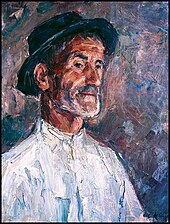Călin Alupi
Călin Alupi (born July 20, 1906 in Vancicăuț , Bessarabia , † September 19, 1988 in Iași ) was a Romanian post-impressionist painter who, along with Corneliu Baba and Alexandru Ciucurencu, was one of the most important Romanian artists of his time. His works can be seen in the largest art museums in his home country as well as in many galleries in the rest of Europe.
Life
As the son of poor farmers in Bessarabia, today's Ukraine , Alupi's childhood and youth were shaped by life on the small farm, in the midst of nature and the surrounding landscape. His early memories of the area and the simple life of the rural population formed the basis of his life's work as an artist. At the age of 13 he attended Sedriceni high school , where he discovered his desire to paint. He was promoted by his teacher at the time, Nicolae Popovici Lespezi . In 1925, at the age of only 17, he entered the Academy of Fine Arts in Iași under the direction of Ștefan Dumitrescu . Alupi lived in poverty all her life, but especially at that time she was a big obstacle, so that Alupi could only stay at the university with the help of a small scholarship. In 1933 he began exhibiting his paintings, initially together with other painters and later alone. Two years later, he moved to his former college as an art teacher.
In 1940 Alupi was drafted into the front during the Second World War , where he remained for the entire duration of the war. His task was to record positions of enemy positions in drawings. After the armistice was signed, he walked all the way home from Odessa , developing chronic stomach and kidney problems. These health problems forced him to undergo ten operations and prevented him from continuing his career.
In 1947, at the age of 40, he was appointed professor of fine arts at his former university in Iași. In the same year he married his wife Sandra Constantinescu Ballif, who three years later gave birth to his daughter Antonia Alupi , who is now an art teacher in Paris .
After the university closed in 1954, Alupi and his family moved to the Romanian capital, Bucharest . In the following nine years he worked as a professor of fine arts at the University of Bucharest, before he returned without his family in 1963 to reopen the Academy in Iași, which was now called the Pedagogical Institute. After his retirement in 1968 he moved back to his family in Bucharest, where he stayed for another twelve years. Not aiming for great fame, he never wanted to work under the observation of the communist regime. Therefore he was out of sight for a long time and completely refrained from self-promotion. In 1980, accompanied by his wife, he moved for the last time to his former hometown of Iași, where he lived until his death in 1988.
Painting style
As a draftsman, his works are primarily characterized by their precise and at the same time powerful and dynamic processing. His subjects often show simple and realistic motifs that contain a deeper meaning of human nature and the Romanian landscape. He was quick to paint and had a gift for creating a strong emotional connection with his subject. His technique was not based on elaborate compositions, but on an authentic representation that contained his affection for the "common man" and a poor society from which he himself came and which exerted the greatest influence on him. This motif unites all of his works. In his opinion, rural subjects such as trees, pets, flower meadows or simple huts were the “most honest” motifs that most stories have to tell. His task for him was to emphasize the sincerity of the objects or people and not to gloss over them artistically, or, as Alupi means personally, not to “lie” to his motives.
Many art researchers therefore see in Alupi's creativity an “innocent love” that kindled between painter and motif at the moment of his work and should therefore always be considered when looking at his works.
Exhibitions
During his life, Alupi exhibited a large number of his works at regular intervals of two to three years. The regional art exhibition in his hometown Iași and the annual fair of fine arts in Bucharest should be mentioned in particular. His reputation quickly spread abroad, so that more of his pictures were shown at group exhibitions in Sofia (1954) and Warsaw (1955). He soon gained a certain degree of fame in Western Europe, which allowed him to accompany exhibitions in Rome and Trieste (1971) as well as in Paris and Saint-Germain-en-Laye (1978).
The largest collection of his most important works was published in 2002 during his memorial exhibition in the Romanian State Palace in Bucharest. The 150 works were brought together from numerous museums and private collections in Europe and financed by the Romanian Parliament.
Web links
- www.alupi.com : Website for the Association des amis de Călin Alupi in Paris with biography, reviews and works
- Biography in English on Answers.com
- Atelier Alupi : an art atelier founded by Alupi in Paris in 1983, currently run by his daughter and grandson
Individual evidence
- ↑ http://www.alupi.com/biographie-en
- ↑ http://www.alupi.com/biographie-en
- ↑ http://www.alupi.com/biographie-en
| personal data | |
|---|---|
| SURNAME | Alupi, Calin |
| BRIEF DESCRIPTION | Romanian post-impressionist painter |
| DATE OF BIRTH | July 20, 1906 |
| PLACE OF BIRTH | Vancicăuț , Bessarabia |
| DATE OF DEATH | September 19, 1988 |
| Place of death | Iași |

